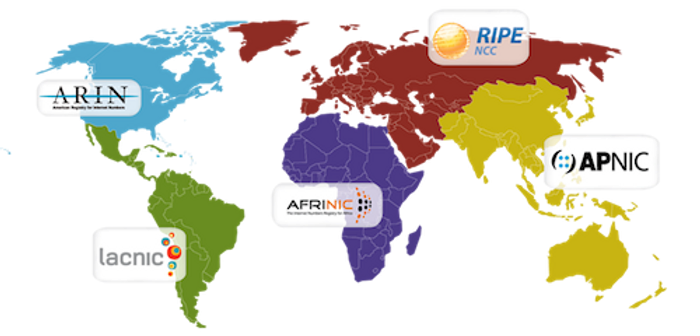
No matter the location, every computer that connects to the internet needs a unique IP address. So how do computers worldwide get their IP addresses? Is it an on-demand service? Or is there a single system that can manage everything for everyone? The answer is “no,” which is why there is a concept known as the “Regional Internet Registry,” or RIR for short.
What Are Regional Internet Registries (RIRs)?
A Regional Internet Registry, also known as RIR, is a non-profit organization or a governing body entrusted with allocating, managing, maintaining, and documenting information such as IP addresses and autonomous system (AS) numbers within a certain geographic region.
As time passed, the regional Internet registry system developed. Finally, the responsibility for administration was split among registries designated for each of the world’s five regions, including AFRINIC, LACNIC ARIN, APNIC, and RIPE NCC (more on this later!)
Informal communication between the various Regional Internet Registries is facilitated by the Number Resource Organization (NRO), an unincorporated group that serves as a coordinating organization to take action on issues of global significance. All five registries are NRO members.
RIRs and NRO
Since its inception in 2003, the Number Resource Organization (NRO) has been operating as a charitable slash non-profit organization. The so-called founding Regional Internet Registries (RIRs) all agreed to the terms of the NRO Memorandum of Understanding, which established the NRO as the organization responsible for coordinating all activities pertaining to the RIRs’ interests.
NRO has committed to coordinating the system that manages internet number registries. In addition to this, it ensures the continuity of the policy formulation process that is currently in place and provides support for the operations of all five RIRs in their collaborative initiatives.
The Number Resource Organization (NRO) signed an update to the original agreement in August 2020. Additional evidence suggests that this non-profit organization intends to ensure that the registration system retains its one-of-a-kind characteristics. On the other hand, it promises to conduct its business more openly and honestly to guarantee the system’s reliability, efficiency, and performance.
Simply put, NRO is involved in resource certification, producing RIR data reports, and functions as the structure’s coordinator for worldwide policy. Even though NRO is not responsible for allocating the resources, it plays a critical role in ensuring that RIR-based cooperation is effective.
Below, we’ll boil down the Regional Internet Registries (RIRs) to the bare bones so that you may carefully understand what it is all about and how they make the Internet run in the digital age. But before getting to the nitty-gritty, let’s take a look at the history of RIRs.
A Glimpse at the History of Regional Internet Registries
From the very beginning, every internet-connected device required an IP address—a one-of-a-kind set of numbers that specifies the device and enables it to be identified on the network. Since each connected device must have its distinctive address for the system to function properly, the distribution of IP addresses needed to be meticulously recorded to prevent any conflicts.
During its inception, the global IP address registry was nothing more than a list of IP address ranges alongside the organizations’ data to whom those addresses were allocated. The list grew as the years went on, and it was all because of the many companies that started following the trend of using the internet. As the number of entries increased, the Internet Assigned Numbers Authority (IANA) was established to take on the responsibility of maintaining a list of all IP addresses.
The number of organizations that joined the internet continued to increase, and as a result of the internet’s rapid growth around the world, it became difficult for the IANA to keep up with the demand for IP addresses. As a result, in 1992, the Internet Engineering Task Force recommended that subsidiary organizations must manage internet number resources at a regional level.
The Emergence of Five Regional Registries
Finally, the Regional Internet Registries (RIRs) were founded and have since taken over the maintenance and local assignment of IP addresses in collaboration with the Internet Assigned Numbers Authority (IANA). In addition to much other information, these registries maintain a record of the organizations that lease IP addresses and sell IPv4 address spaces.
RIR Establishment
In the 1990s, as the Internet expanded rapidly, it became apparent that the system would need some kind of administration. A single centralized system became impractical due to the demand all over the globe; thus, regional registries were developed during the 1990s and early 2000s, with the fifth registry taking place in 2005. As of 2010, five Regional Internet Registries autonomously manage domain names, IP addresses, and autonomous system (AS) numbers in their respective regions.
●AfriNIC – African Network Information Centre (Mauritius)
●APNIC – Asia-Pacific Network Information Centre (Australia)
●ARIN – American Registry for Internet Numbers (United States)
●RIPE NCC – Reseaux IP European’s Network Coordination Centre (Netherlands)
●LACNIC – Latin America and Caribbean Network Information Centre (Uruguay)

ARIN is responsible for managing both Canada and the US. LACNIC covers South America, Central America, and Mexico. The countries that make up the Caribbean are split between two different regional Internet registrations. The RIPE NCC oversees operations in Europe, the Middle East, and Central Asia. The remainder of Asia, in addition to Australia and the surrounding Pacific Rim, falls within the purview of APNIC. AfriNIC, the fifth registry to be added, manages Africa.
The Regional Internet Registries (RIRs) serve as self-regulatory organizations and have the jurisdiction within their respective areas to manage and register IP addresses and Autonomous System numbers, in addition to providing associated services. However, this authority is only possible with the active participation of local communities, which guarantees that the users define the regulations that govern the distribution and use of these numeric resources.
While RIRs operate autonomously, they collaborate and coordinate their actions to serve customers better. NRO, a coordinating entity that unifies the five RIRs, is responsible for some of this activity. Believe it or not, the entire framework has provided several resource management systems that are scalable, effective, reliable, open, and fair for over a decade. This has been essential to the rapid expansion of the internet in the past, and it will continue to be so in the future.
RIR Operation, Oversight, and Stability
In conformity with the nation’s legal framework, each RIR serves its own area as a non-profit, association-based organization that its constituent members run. RIRs are responsible for distributing internet number resources in accordance with the policies made by their particular regional communities, formed via established processes that are open, inclusive, and bottom-up in nature.
Additionally, boards of directors are responsible for providing supervision through fiduciary responsibility, strategic direction, and verification of the policy creation process. The methods introduced to prevent capture are the election procedures, bylaws, articles of incorporation, and membership rules adopted by Regional Internet Registries (RIRs). Nevertheless, a Joint RIR Stability Fund was also established to guarantee the robustness of the global RIR system.
RIR Communities
Regional Internet Registry (RIR) communities include everyone interested in the regulations that control the distribution of internet number resources and the number of resources themselves. Participants in the community get the chance to participate in other internet governance activities that are directly relevant to the management of internet number resources. Some examples of these activities include the Address Supporting Organization Address Council (ASO AC).
RIR Meetings
Policy debates are held during RIR meetings, which are open to participation from anybody, either in person or remotely (online). About twice a year, each RIR gets together for a meeting. During these meetings, in addition to talks on Internet number resource policy, there are also opportunities for attendees to participate in technical presentations, seminars, and training courses.
Upcoming RIR Meetings: ARIN – APNIC – AFRINIC – LACNIC – RIPE NCC RIRs and Industry Development
As mentioned before, the RIRs continue to maintain strong participation levels. In a similar vein, they encourage any interested parties to take part in their activities. The RIRs are involved in deploying innovative technologies in various fields (such as UMTS mobile telephony, IPv6, GPS, and xDSL-based Internet services). The pre-existing regional procedures are both flexible and open enough to accommodate the incorporation of such recent innovations into policy creation.
Representatives from many industries often participate in policy-related activities, including speaking at plenary sessions, contributing to working groups, and more. To encourage industry convergence on open standards and policy procedures, the RIRs cultivate partnerships with industry organizations, especially those with representational and developmental roles.
Many parties have legitimate interests in the allocation and registration of IP addresses, and the Regional Internet Registries (RIRs) continue to work with these stakeholders to reach an agreement on IP address allocation problems throughout the internet community.
Are Regional Internet Registries Really Needed?
Since there is a finite amount of IPv4 addresses, the function of RIRs is of vital significance on a worldwide scale. Undeniably, the resources are valuable due to their limited availability. Therefore, the burden of allocating these restricted IPs and ASNs to LIRs (Local Internet Registries), who are subsequently responsible for allocating them to end-users, falls squarely on the shoulders of RIRs.
The currently used IP version, referred to by its technical name, IPv4, does not have an endless number of accessible addresses. Due to this, the organizations responsible for the administration realized that there was an immediate need for sufficient IP addresses for everyone and a method for effectively assigning them, followed by the careful and astute management of the address inventory.
To make everything function properly, the RIR developed certain guidelines, where each RIR must adhere to a neutral policy on allocating and distributing IP addresses. This prevents any RIR from stockpiling IP addresses for users in its geographical area or taking any other action that might put users at a disadvantage. After all, a network is destined to fail without consistently obtained IP addresses, allowing individuals to communicate with other users locally and globally.
IANA assigns one /8 address block to every new Regional Internet Registry (RIR) for 18 months following the Policy for the Allocation of IPv4 Blocks to Regional Internet Registries. If an RIR has less than half of the available space in the /8 block and that space will not be enough to meet the demand for the subsequent nine months, the Internet Assigned Numbers Authority (IANA) will grant extra address space. As of right now, the distribution of IPv4 address space looks like this.
The Role of the Regional Internet Registry (RIR)
As discussed previously, RIRs are organizations responsible for administering, managing, distributing, and registering Internet Protocol (IP) addresses and Autonomous System (AS) numbers within their respective areas. The global RIR system guarantees that each Internet number resource is uniquely allocated to one party, which is necessary to maintain the proper operation of the Internet, and that these resources are dispersed according to the level of justification required for each case.
In addition, since each RIR is located in a unique geographic location, Internet Protocol (IP) addresses and Autonomous System Numbers (ASNs) are dispersed uniformly over the globe. This ensures that the global network will continue to operate properly, stops a single location from hoarding all the resources, and leaves the other regions unable to escape their current situation.
Regional Internet Registries are ultimately responsible for the equitable and secure assignment and distribution of IP addresses, and they also act as representatives for the individuals in their respective regions. The policies that the communities of each RIR work together to design using their PDPs determine how the RIRs allocate Internet number resources within their respective areas.
Global Incident Management
To correctly identify components, such as connection endpoints (IPv4 and IPv6 addresses and TCP/UDP port numbers), routing devices, protocol zones, and networks that communicate with one another using the TCP/IP protocol stack depend on a group of numbering resources. These resources can be found in many different formats (autonomous systems). Each of these identifiers has to fulfill a unique set of requirements, but they must all be distinct within the context of the provided scope.
In simple words, IPv4 and IPv6 addresses and Autonomous System Numbers (ASNs) must be globally unique. This means that no two devices or networks on the Internet should have the same addresses, nor should two networks utilize the same ASN. The maintenance of multiple registries of the unique numbering resources is what guarantees this one-of-a-kind quality.
These registries follow a hierarchical structure, with the IANA at the top and the five RIRs directly below. [APNIC1] provides readers with a comprehensive historical summary of the development of the RIR system. Meanwhile, IANA is responsible for allocating resources, not directly to individual users but rather to RIRs. The RIRs, in turn, provide the available resources to individual users or regional or national registries located further down in the hierarchy.
The RIRs do not decide on the management of the numbering resources that they control on their own. Instead, they use a set of policies produced by their local communities via a policy development process (PDP) that operates from the bottom up. RFC 7020 [RFC7020] contains further data and information on the RIR system. [RFC7020] Therefore, the provision of registration services as a means of assuring the one-of-a-kindness of the allotted numbers is the RIR’s primary duty.
This function or service is offered to a local community mostly composed of Internet service providers (ISPs). RIRs are also responsible for providing some services to the larger Internet community. This larger community encompasses the organizations that directly get numbered resources from the RIRs and additional parties. When discussing incident response, some may include members of law enforcement and Computer Security Incident Response Teams (CSIRTs).
The Future of RIRs
Since its inception in 1990, the RIR system has undergone rapid development, received substantial community support, and has been relatively unaffected by the political wrangling characteristic of the registration systems of other Internet resources. Without a shadow of a doubt, a significant contributor to this position is the early decision of the IETF to establish easily accessible and open forums for the numerous interested stakeholders located in the different areas.
However, while new technologies like broadband services, GPRS, and IPv6 may present the Regional Internet Registries (RIRs) with operational and policy challenges, these new technologies also present opportunities for improved global cooperation where distinctive regional concerns are represented more effectively than they have ever been represented before. It is hoped that in the years to come, establishing additional RIRs will only widen and improve the all-inclusive nature of RIR actions.
The Final Cut
Regional Internet Registries (RIRs), which share a worldwide obligation by the Internet Assigned Numbers Authority (IANA), are the entities responsible for controlling address space on the Internet under the present system. This regime is now well demonstrated, but it has developed over the course of 10 years from a much more straightforward and centralized system.
Moving forward, it is essential to have a solid understanding that the development of the Regional Internet Registry system was not only the logical consequence of the expansion of the Internet but also the inherent need to improve and decentralize a rising administrative responsibility. On the other hand, it sprang from and closely paralleled the technological history of the Internet Protocol, particularly the creation of today’s IP addressing and routing architecture.
The RIR system has, in a comparatively short time, developed into a reliable and resilient framework for the administration of Internet address space. It is maintained today by self-regulatory techniques that are well established. Additionally, Regional Internet Registries retain their validity and relevance by steadfastly adhering to open, transparent, and participatory decision-making processes.
Finally, we unpacked everything you need to know about Regional Internet Registries (RIRs). This brings us to the end of this extensive RIR guide. Now it’s time to hear from you. Any questions? Or maybe there’s something we missed? Either way, feel free to leave a comment below.



Pingback: The Role of APNIC in Internet Governance - NRS
Pingback: - NRS
Pingback: Understanding the Crucial Role of RIRs in Shaping Internet Infrastructure - NRS
Pingback: Why Regional Internet Registries Matter - NRS.help
My family members always say that I am wasting my time here at net,
except I know I am getting knowledge all the time by reading such fastidious posts.
Greetings! Very useful advice in this particular post! It’s the little changes that make
the biggest changes. Many thanks for sharing!
Good day! I just want to give a huge thumbs up for the nice data you’ve got here on this post. I will likely be coming again to your blog for more soon.